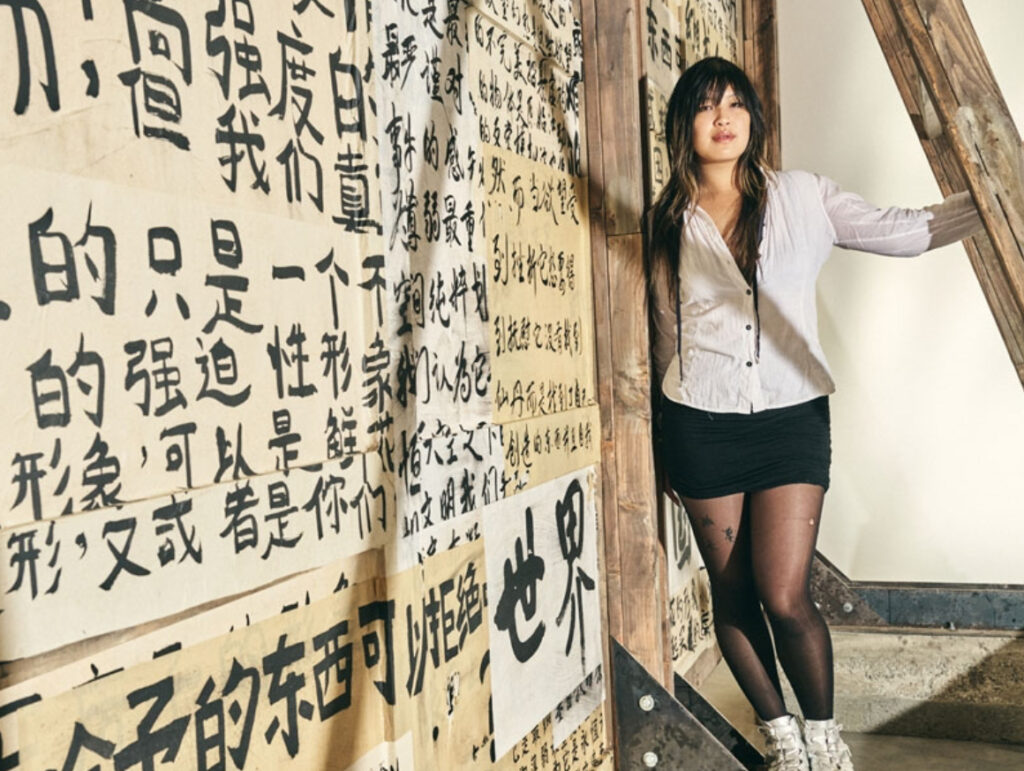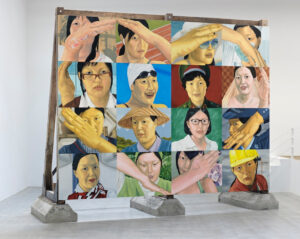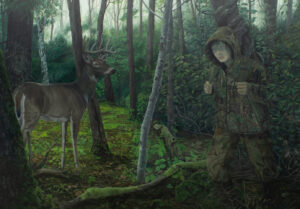


In a city obsessed with beginnings, Amanda Ba’s Developing Desire feels like a reckoning with aftermath. Her recent exhibition at Jeffrey Deitch doesn’t offer a clean narrative, but rather a slow procession through suspended states—construction and collapse, want and withdrawal, clarity and opacity.
Across oil canvases and installation, Ba does not simply depict spaces, but excavates what lingers beneath their surfaces: memory, tension, aspiration, and the thick residue of economic ideology.
There is no single “why” to grasp in this show, no thesis to swallow whole. And yet, the question quietly hums beneath each image: Why do we want what we want? In Ba’s hands, desire is not pure impulse, but a system—an infrastructure that directs our gaze, informs our ambitions, and ultimately determines the shape of the cities we live in and the lives we attempt to build.
Rubble as Iconography
Many of the works in Developing Desire feature landscapes fractured and fragmented. Rubble becomes not only backdrop, but central motif. These are not post-apocalyptic fantasies, nor are they romanticized ruins. Ba’s debris piles are particular. They call to mind the accelerated urban development of modern China—the steel-and-glass rise of cities like Shenzhen and Chongqing, the demolitions, the rebar bones of ambition exposed in mid-transformation.
In works like Rubble Titan, massive female figures inhabit these spaces, not as victims or symbols, but as occupants. They lean, recline, watch. They are witnesses to progress and its ghosts. The female body, painted with tactility and weight, suggests a tension between vulnerability and monumentalism. These are not passive muses, but beings tethered to their environments, responding to the socio-political materiality around them. They are desire made flesh, yet also boredom, patience, and refusal.
The emotional logic of the exhibition is not linear. Instead, Ba’s canvases radiate in all directions—each painting a site of accumulation, decay, renewal.
Building the Erotic from Industry
Desire, in Ba’s world, is not limited to romance or flesh. It emerges in blueprints, in housing policies, in the steel skeletons of high-rises. She draws from the concept of libidinal economy, a theoretical framework that treats desire as both emotional and systemic—a force that drives capital as much as it does longing.
Housing, particularly in the context of contemporary China, becomes a rich symbol of this dynamic. There, home ownership is not just a matter of shelter, but a prerequisite for marriage, family, social mobility. A man without property is often seen as unmarriageable. Desire is thus formalized, priced, exchanged.
In Ba’s visual lexicon, apartment buildings are not just structures—they’re manifestations of psychological infrastructure. They represent the frustrating mismatch between what we’re taught to want and what we’re able to attain. They’re erotic objects in a broader, Freudian sense—not because they arouse, but because they stand in for deeper, often unreachable urges. We may hunger for love, permanence, validation—but we buy square footage, we renovate kitchens, we place down payments.
The City as Internal Terrain
Across the exhibition, Ba shifts away from the deep crimson palette that characterized earlier work and moves into earth tones, muted grays, steel blues. The world she paints now is dustier, more ambiguous, perhaps more honest. If the color red once suggested political potency or mythic energy, these new hues suggest something more lived-in. They’re the colors of concrete, clay, exposed insulation—the palette of process rather than completion.
In Titan City, different phases of urban development exist simultaneously. One corner of the canvas shows scaffolding wrapping around a half-born tower. Another features a pile of crushed bricks. Still elsewhere, a cluster of shining high-rises pushes into the distance. The woman in the painting does not belong to any one phase. She simply endures them all.
This is what Ba paints best: the simultaneity of progress and destruction, the cyclical rhythm of capitalist futurity. In her hands, the city becomes both a map and a mirror—charting not just physical expansion, but emotional circuitry. It’s no longer a backdrop for human drama; it’s a living system of frustration, adaptation, and projection.
Labor, Restraint, and Afterparties
Though it exists beyond the gallery space, the story of Developing Desire includes the labor that brought it into being. Months of focused work, materials acquired piece by piece, budgets stretched and recalibrated. There is no romanticism here—just the disciplined, often punishing logistics of putting together a show in a city where attention spans are short and expectations high.
And then, as Ba herself has alluded to elsewhere, there’s the afterparty. Not as escapism, but as self-recognition. An earned moment of excess after prolonged austerity. If the exhibition investigates unfulfilled or misdirected desires, the afterparty momentarily satiates them. A rented hotel suite, a cigarette outside the gallery, a moment of laughter surrounded by friends and strangers—it’s all part of the same cycle.
Even in celebration, the architecture of longing remains. There’s a beauty to that contradiction, and Ba inhabits it fully.
Sculpture and the Language of Scar Tissue
In the centerpiece installation Heart Wall, Ba pushes beyond canvas, working with concrete, oxidized steel, inked calligraphy paper, and wood. Here, language is folded into structure—literal fragments of thought embedded within a cracked industrial form.
The wall recalls propaganda murals, demolition boards, and abandoned billboards. It feels both permanent and precarious. Viewers can walk around it, but not through. It imposes. It conceals. And it speaks, though in fragments and echoes.
This sculptural turn in Ba’s practice expands her vocabulary. It reveals a deepening interest not only in space, but in time. The wall exists in layers: built up, broken down, written upon. Like a psyche. Like a city.
The Artist as Archaeologist
Amanda Ba’s practice is driven by excavation—not just of physical space, but of symbolic infrastructure. Her images read like cross-sections. They reveal what buildings conceal, what society forgets, what modernity leaves unfinished.
She is not a documentarian. Nor is she a propagandist. What she offers instead is a psychological realism, where fantasy and theory intersect. Her work doesn’t demand answers. It doesn’t resolve into one moral stance. Rather, it invites viewers to locate themselves in the push-pull between desire and detritus—to ask what we long for, and why, and what it costs.
Ba’s brilliance lies in her refusal to resolve that tension. She shows us women made powerful by ambiguity, cities made vulnerable by ambition, and systems made fragile by the very dreams that built them.
Final Thoughts: What We Build, What We Inherit
If Developing Desire teaches anything, it’s that progress is never clean. It leaves behind wreckage—psychic, physical, emotional. Amanda Ba does not fear that rubble. She dwells in it. She paints it. She walks through it as if walking through memory, ideology, grief.
Desire, for Ba, is not a destination. It’s an engine. It drives us forward, even as we circle the same questions. It pushes us to build cities, to paint canvases, to host afterparties in hotel rooms, to keep going.
Her work reminds us that the gap between what we want and what we have will always exist. The power lies in what we create to fill that gap—in stories, in spaces, in images that haunt us not because they offer answers, but because they ask the right questions.
No comments yet.








